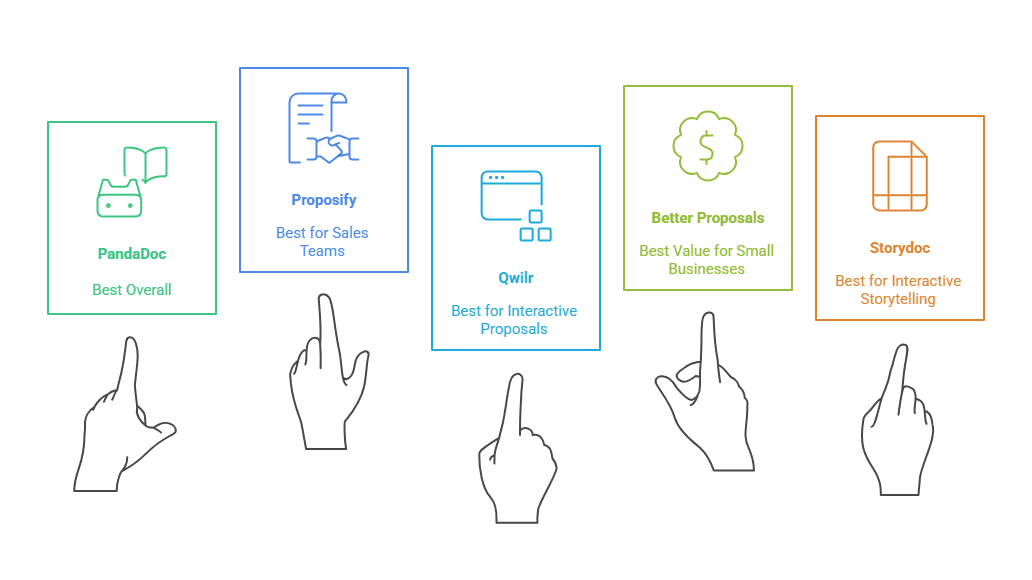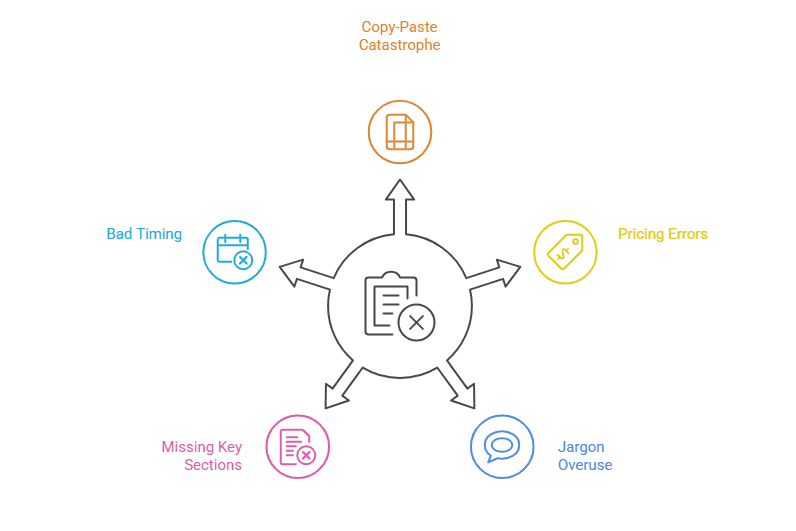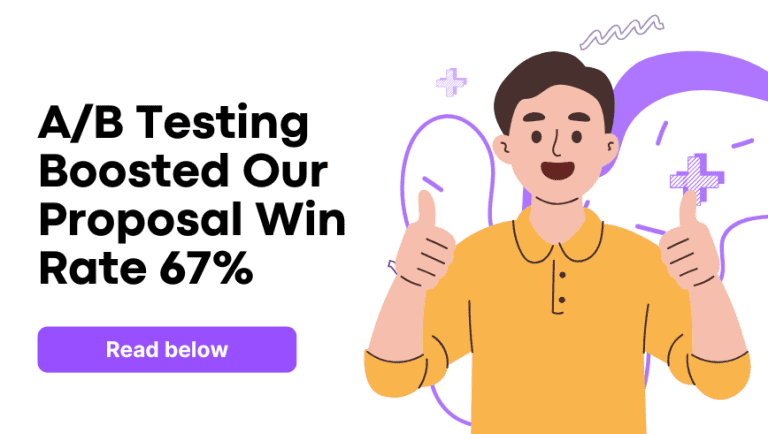في الأسبوع الماضي، استمعنا إلى محادثة في غرفة اجتماعاتنا. كانت إحدى صاحبات المشاريع الصغيرة تشرح كيف خسرت صفقة بقيمة 15,000 دولار أمريكي - ليس بسبب ارتفاع أسعارها أو افتقار خدماتها للقيمة، بل لأن عرضها بدا وكأنه كُتب عام 2011. كان ملف PDF ثابتًا به بعض الأخطاء الإملائية، وتفتقر إلى آلية متابعة. لم يُجبها عميلها المحتمل. هذا الصمت؟ كلّفها أسابيع من التردد والتردد.
ذكّرنا هذا بأن اختيار أفضل برنامج عروض أسعار للشركات الصغيرة لا يقتصر على كتابة مستندات أفضل فحسب، بل يشمل أيضًا الحفاظ على حيوية الصفقات. في عام ٢٠٢٥، ستحتاج الفرق الصغيرة إلى أكثر من مجرد ملفات وورد ومرفقات البريد الإلكتروني. ستحتاج إلى أدوات سهلة الاستخدام تُقلل الأخطاء، وتُحسّن العرض التقديمي، وتُسرّع من عملية تقديم العروض مع إمكانية الاطلاع على ما يحدث لاحقًا.
لقد راجعنا أشهر الأدوات لنقدم لكم هذه المقارنة المفصلة لبرامج عروض الأعمال. كل شيء هنا مصمم خصيصًا للشركات الصغيرة: فرق عمل محدودة، وميزانيات محدودة، ورغبة ملحة في إثارة الإعجاب دون تعقيدات.
أفضل 5 برامج مقترحات للشركات الصغيرة بناءً على الشعبية والتقييمات

1. PandaDoc – الأفضل بشكل عام
باندا دوك برنامج متكامل لإدارة العروض، يُناسب الشركات الصغيرة التي تبحث عن التوسع والسرعة. يُبسّط كل شيء، من الإنشاء إلى التوقيع، مع الحفاظ على حضور احترافي للعلامة التجارية.
الميزات الرئيسية:
- تحميلات مستندات غير محدودة وتوقيعات إلكترونية ملزمة قانونًا
- محرر مرئي مع وظيفة السحب والإفلات
- التتبع في الوقت الحقيقي وإشعارات العملاء
- مكتبة محتوى قابلة للتخصيص وخيارات العلامة التجارية
- غرف الصفقات التعاونية
التسعير:
- المبدئي: $19/الشهر يتم دفعها سنويًا
- الأعمال: $49/الشهر يتم دفعها سنويًا
- المؤسسة: التسعير المخصص متاح
لماذا هو موثوق به:
يُساعد PandaDoc الشركات على إتمام 18% صفقة إضافية، وفقًا لتقارير المستخدمين. إنه آمن، ويتوافق مع معايير SOC 2 من النوع 2، ومتوافق مع اللائحة العامة لحماية البيانات (GDPR). بالنسبة للفرق التي ترغب في توفير كل شيء في منصة واحدة دون الحاجة إلى أدوات توقيع أو تتبع منفصلة، فهو يتفوق على أدوات برامج الاقتراحات.
يمكنك أيضًا تعلم كيفية كتابة مقترح عمل للاستفادة القصوى من قوالب PandaDoc.
2. Proposify – الأفضل لفرق المبيعات
بالنسبة للشركات حيث تكون المقترحات مهمة يومية، اقترح صُمم لمساعدة فرق المبيعات على العمل بسلاسة وسرعة الاستجابة. يوفر قوالب منظمة وتحليلات فعّالة.
الميزات الرئيسية:
- مكتبة محتوى مركزية تحتوي على كتل قابلة لإعادة الاستخدام
- جداول التسعير الذكية مع التفاعلية
- سير عمل الموافقة القائمة على الأدوار
- تكاملات إدارة علاقات العملاء (CRM) بما في ذلك Salesforce (خطة العمل)
- تحليلات مقترحة مفصلة وتتبع المشاركة
التسعير:
- الأساسي: $19/الشهر (الفوترة السنوية، الحد الأقصى لمستخدمين)
- الفريق: $41/الشهر (الفوترة السنوية)
- الأعمال: $65/الشهر (الفوترة السنوية، 10 مستخدمين أو أكثر)
لماذا تختاره الفرق:
يقول مستخدمو Proposify أن المقترحات المقدمة تأخذ مجراها 17 دقيقة لإنشاء. بالإضافة إلى ذلك، 43% منهم يتم قبولها خلال يوم واحد. تعكس هذه الأرقام الكفاءة. بالنسبة للفرق التي تدير صفقات متعددة، تُعدّ هذه السرعة أمرًا بالغ الأهمية. بفضل تصميمها المُركّز على المبيعات والأتمتة، يُعدّ هذا البرنامج برنامجًا موثوقًا به لعروض الأسعار للشركات الصغيرة.
3. Qwilr – الأفضل للعروض التفاعلية
كويلر يقدم تجربة عرض عروض عبر الإنترنت، بتصميم عصري، ويعمل كموقع إلكتروني صغير. للشركات التي تسعى للتميز، يُضيف هذا الموقع مستوى من التفاعلية لا توفره ملفات PDF.
الميزات الرئيسية:
- جداول التسعير في الوقت الفعلي مع التحديثات التفاعلية
- واجهة الجوال أولاً
- مقاطع الفيديو المضمنة وحاسبات العائد على الاستثمار
- إمكانيات الدفع عبر الإنترنت
- تخصيص مجال العلامة التجارية والتصميم
التسعير:
- الأعمال: $35/الشهر يتم دفعها سنويًا
- المؤسسة: $59/الشهر يتم دفعها سنويًا (الحد الأدنى 10 مستخدمين)
لماذا هو مختلف:
تستخدم الشركات الصغيرة Qwilr لتقليل تأخير الدفع. يُبلغ العديد منها عن الدفعات خلال يومين. يُعدّ تنسيقه المُحسّن للهواتف المحمولة فعالاً عند مراجعة المشترين للعروض عبر الهواتف. تُعيد أدوات مثل Qwilr تعريف كيفية... أناتُعزز المقترحات التفاعلية التفاعل. مع الذكاء الاصطناعي يغير إدارة طلبات تقديم العروض ولعبة كتابة المقترحات، تحصل Proposify على نقاط لكونها متقدمة.
4. عروض أفضل - أفضل قيمة للشركات الصغيرة
مقترحات أفضل يُبقي الأمور بسيطة. يتميز بتصميم رائع، وميزات أساسية، وسعر مناسب. إنه مثالي للشركات ذات الموارد المحدودة التي لا تزال ترغب في إبهار الآخرين.
الميزات الرئيسية:
- الوصول إلى أكثر من 160 قالبًا من تصميم المصممين
- التوقيعات الإلكترونية المتكاملة ومدفوعات Stripe/PayPal
- دعم الدردشة المباشرة المدمج للمستلمين
- الرؤى والتقارير
- مزامنة إدارة علاقات العملاء
التسعير:
- المبدئي: $13/الشهر يتم دفعها سنويًا
- المميز: $21/شهريًا يتم دفعها سنويًا
- المؤسسة: $42/الشهر يتم دفعها سنويًا
لماذا هو عملي:
يرى المستخدمون معدل فوز 44%، وجميع الخطط تتضمن قوالب غير محدودة. مع دعم فني متوفر على مدار الساعة طوال أيام الأسبوع، يُعدّ هذا البرنامج مثالاً ممتازاً على برامج عروض الأسعار المعقولة التي تُقدّم نتائج احترافية.
5. Storydoc – الأفضل لسرد القصص التفاعلية
قصة وثائقية يُنشئ عروضًا تفاعلية قائمة على التمرير. صُمم هذا التطبيق للشركات التي تبيع بصريًا أو سرديًا، ويوفر بديلًا عصريًا للشرائح والمستندات الثابتة.
الميزات الرئيسية:
- مسودات المقترحات التي تم إنشاؤها بواسطة الذكاء الاصطناعي بناءً على المدخلات
- رسوم متحركة مخصصة وكتل تصميم تفاعلية
- مزامنة CRM مع التخصيص الديناميكي
- تحليلات المشاركة
- عناوين URL ذات العلامة التجارية وخيارات النطاق
التسعير:
- المبدئي: $40/الشهر
- برو: $60/الشهر
- الفريق: مخصص (10+ مقاعد)
لماذا هو فعال:
يقضي العملاء وقتًا أطول في قراءة مقترحات Storydoc بفضل هيكلها الجذاب. يستخدم التحليلات السلوكية لمساعدة الفرق على تحسين مقترحاتهم المستقبلية. يُعدّ خيارًا مثاليًا إذا كنت مهتمًا بكيفية تفاعل عملائك مع مقترحاتك.
إذا كنت تريد استكشاف المزيد من الخيارات، يمكنك أن تفكر في Loopio وبدائلها.
مكافأة: أفضل برنامجين لعرض الأفكار التمويلية
الملعب - الأفضل للتعاون
يقذف يستخدمه أكثر من 3 ملايين فريق لإنشاء مجموعات المستثمرين بدقة وبعمل جماعي.
الميزات الرئيسية:
- مولد سطح الذكاء الاصطناعي
- التحرير متعدد المستخدمين في الوقت الفعلي
- أكثر من 100 قالب احترافي
- رؤى المشاركة
- قوالب ذات علامة تجارية وتتبع العرض التقديمي
التسعير:
- مجانًا لـ 5 أعضاء و2 ضيف
- تبدأ الخطط المدفوعة من $10/مستخدم/شهر
Slidebean – الأفضل للمجموعات التي تعتمد على الذكاء الاصطناعي
يوفر Slidebean تصميم شرائح آليًا ونمذجة مالية للمؤسسين الذين يقومون بإعداد عروض التمويل.
الميزات الرئيسية:
- مساعد محتوى الذكاء الاصطناعي
- قوالب مالية وعروض تقديمية جاهزة
- التنسيقات التي تم اختبارها بواسطة VC
- الوصول إلى خبراء التصميم
التسعير:
- مجاني مع وظائف محدودة
- يبدأ Pro من $12/الشهر
لا تحتاج كل المواقف إلى عرض تقديمي كامل. إذا كان وقتك ضيقًا أو كنت تطرح فكرة بسيطة، اقتراح عمل من صفحة واحدة قد يعمل بشكل أفضل في الواقع.
أدوات اقتراح مجانية مع ميزات احترافية
مستندات جوجل + قوالب مجانية
بالنسبة للشركات التي ليس لديها ميزانية ولكنها تتمتع بقدر كبير من الدافع، فإن Google Docs ينجز المهمة.
سمات:
- الوصول إلى مئات القوالب
- التعاون السهل
- التحرير المستند إلى السحابة
- أدوات التنسيق البسيطة
مثالي للشركات الناشئة في المراحل المبكرة، وخاصة عند التعلم كيفية كتابة مقترح عمل.
كانفا + جوتفورم
حل مرئي يجمع بين قوالب Canva وتوقيعات Jotform المستندة إلى النماذج.
سمات:
- تصميمات مقترحة جميلة وقابلة للتخصيص
- منشئ النماذج بالسحب والإفلات
- جمع التوقيعات الإلكترونية
- تصدير بصيغة ملفات PDF
مناسب بشكل أفضل للعاملين لحسابهم الخاص والمؤسسين الفرديين الذين يريدون الشكل والوظيفة.
أخطاء شائعة في عروض الأعمال تُفسد صفقات الأعمال الصغيرة

حتى أفضل العروض تفشل لأسباب يمكن تجنبها. لقد رأينا شركات ذكية تخسر صفقات ليس بسبب ما قالته، بل بسبب طريقة قولها، أو وقت إرسالها. هذه هي... أخطاء صغيرة التي تكلف أموالاً حقيقية.
1. كارثة النسخ واللصق
تشير العروض المُرسلة باسم عميل خاطئ إلى إهمال. يُعالج برنامج العروض هذه المشكلة من خلال تكامله مع نظام إدارة علاقات العملاء (CRM) الذي يجمع البيانات الصحيحة.
2. أخطاء التسعير
قد يُؤدي وضع صفر خاطئ إلى إفشال صفقة أو تكبد خسائر. تُتحقق المنصات الحديثة من صحة الأسعار قبل الإرسال.
3. الإفراط في استخدام المصطلحات
الرسائل الواضحة تفوز. أدوات الكتابة المدعومة بالذكاء الاصطناعي تقترح صياغة أبسط، لكنها تحمل في الوقت نفسه قيمة.
4. الأقسام الرئيسية المفقودة
تأكد من تضمين القوالب دائمًا الملخص التنفيذي، التسعير، والشروط، والدعوة إلى اتخاذ إجراء.
5. سوء التوقيت
الانتظار طويلًا قبل المتابعة يعني فقدان الزخم. يساعد تتبع العروض على تحديد وقت المتابعة بناءً على تفاعل العميل المحتمل.
هل تريد التعمق في هذه الأخطاء وكيفية تجنبها؟ هذا الانهيار الكامل يغطي أمثلة حقيقية وإصلاحات تعمل بالفعل.
دليل تنفيذ الأعمال الصغيرة
الأداة ليست هي المشكلة بشكل عام، ولكن لسوء الحظ، في معظم الحالات، يكون الفريق هو المشكلة. خطة خطوة بخطوة مخصص للفرق الصغيرة التي تحتاج إلى الوضوح وليس الارتباك، وتريد طرح برنامج الاقتراح دون أن يتحول إلى مشروع جانبي.
الأسبوع 1-2: الأساس
حدّد مسار عمليتك الحالية. حدّد مواطن التأخير أو الأخطاء.
الأسبوع 3-4: نقل المحتوى
استورد أفضل مقترحاتك السابقة إلى أداتك الجديدة. احفظ الأقسام المفيدة وأنشئ قوالب.
الأسبوع 5-6: تدريب الفريق
اختر قائد فريق قادر على تعزيز تطبيق المنتج. ركّز على التدريب العملي، لا على الميزات فقط.
جاري:
راجع مقاييس مثل معدلات الفوز ومتوسط وقت الإرسال. نفّذ تغييرات صغيرة باستمرار.
ما يمكن أن تتوقعه الشركات الصغيرة في عام 2025
تتطور برامج عروض الأعمال للشركات الصغيرة بسرعة. ما كان يُعتبر اختياريًا قبل عام، مثل التفاعلية أو التصميم المُركّز على الأجهزة المحمولة، ونعم، الذكاء الاصطناعي، أصبح الآن ضروريًا. هذه هي التحولات التي ستُشكّل كيفية إنشاء عروض الأعمال وتتبعها وتقديمها في عام ٢٠٢٥.
اقتراحات مدعومة بالذكاء الاصطناعي
المنصات الآن الاستفادة من الذكاء الاصطناعي اقتراح دراسات الحالة ونقاط القيمة والأسعار بناءً على الصناعة وحجم العميل.
التحليلات السلوكية
اعرف متى وأين ينقر العميل المحتمل أو يتوقف عن القراءة. ركّز متابعتك وفقًا لذلك.
المقترحات التفاعلية
توقع عروض توضيحية ثلاثية الأبعاد، وحاسبات تسعير، وحتى ميزات الواقع المعزز في منصات العروض الأحدث.
التعاون السحابي
لا مزيد من فوضى الملفات. تتم مزامنة كل شيء فورًا، مما يقلل من التداخل.
مقترحات مُحسّنة للأجهزة المحمولة
يراجع العملاء المستندات أثناء تنقلهم. لذا، ينبغي تصميم برنامج عروضك مع مراعاة ذلك.
قائمة مرجعية سريعة للبدء
قد يبدو البدء باستخدام برنامج عروض الأعمال للشركات الصغيرة أمرًا مُرهقًا إذا بالغت في التفكير فيه. تساعدك هذه القائمة على التركيز على التقدم الحقيقي بدلًا من الإعداد المثالي. هذه الخطوات سهلة المتابعة والتكرار.
- قم بمراجعة عمليتك
- حدد أداة بناءً على أهدافك
- إنشاء قوالب قابلة لإعادة الاستخدام
- درب فريقك
- الإطلاق مع عميل حقيقي
البدء بقائمة تحقق واضحة كهذه يُساعدك على تحويل التخطيط إلى تقدم. معظم أدوات الأعمال الصغيرة تتطلب وقتًا لتطبيقها، لكن برامج تقديم العروض هي أحد المجالات التي تُولّد فيها البداية المُركّزة زخمًا منذ اليوم الأول.
بعد تغطية الأساسيات، تأتي الخطوة التالية وهي اختيار منصة تُلبي احتياجاتك الآن ولا تُعيقك لاحقًا. تُغطي هذه القائمة المختصرة العوامل العملية التي تستخدمها معظم الفرق الصغيرة لتضييق نطاق خياراتها.
كيف تختار برنامج الاقتراحات المناسب لعملك؟
إذا كان هذا سؤالك، فإليك نصيحتنا الموجزة. تُركز العديد من الأدوات على ما يبدو جيدًا في مكالمة تجريبية. بدلًا من ذلك، فكّر فيما يناسب عمليتك الفعلية. تُساعدك هذه الأسئلة على تحديد ما هو مهم بناءً على كيفية سير عملك يوميًا.
فكر في:
- حجم عملك الحالي
- من يرسل المقترحات وكم مرة
- سواء كنت بحاجة إلى التوقيعات الإلكترونية أو التحليلات أو مزامنة إدارة علاقات العملاء
- تعقيد صفقاتك
- الميزانية والمساحة للنمو
معرفة هذه الأمور سوف تساعدك على اتخاذ القرار الاختيار الصحيح الذي يناسب عمليات عملك بشكل أفضل.
الأسئلة الشائعة
ما هو برنامج العروض في عام 2025 الذي يوفر أفضل توازن بين الشعبية وتقييمات المستخدمين للشركات الصغيرة؟
يحتل PandaDoc باستمرار أعلى المراتب من حيث الشعبية والأداء. تُقدّر الشركات الصغيرة واجهته السهلة، وسرعة إعداده، وتوقيعاته الإلكترونية غير المحدودة، ومعدل إتمامه المرتفع. إنه أداة متكاملة تتكيف بسلاسة مع قاعدة عملائك المتنامية.
ما هي أفضل أدوات عرض الأفكار الإضافية المصممة خصيصًا لعروض تمويل الشركات الناشئة في عام 2025؟
يُعدّ كلٌّ من Pitch وSlidebean منصّتيْ جمع التمويل للشركات الناشئة. يُعدّ Pitch مثاليًا للفرق التي تحتاج إلى تعاون وهيكل تصميم، بينما يستخدم Slidebean الذكاء الاصطناعي لإنشاء المحتوى، ويُقدّم نماذج مالية تُطابق ما يتوقعه المستثمرون عادةً.
ما هي أدوات الاقتراح المجانية التي توفر الميزات الأكثر احترافية دون أي تكلفة اعتبارًا من يوليو 2025؟
تتيح مستندات جوجل، مع قوالبها المجانية، وCanva وJotform للفرق الصغيرة الوصول إلى ميزات أساسية كالتعاون والتصميم والتوقيعات الإلكترونية دون أي تكلفة. ويستحق مايكروسوفت وورد الذكر هنا أيضًا. فهي خيارات عملية للشركات الناشئة أو المستقلين المبتدئين.
كيف تعمل المقترحات التفاعلية مثل Qwilr وStorydoc على تحسين تفاعل العملاء مقارنة بملفات PDF التقليدية في عام 2025؟
تُحوّل هذه الخدمات المستندات الثابتة إلى صفحات ويب قابلة للتمرير ومتجاوبة. يُمكن للعملاء التفاعل مع الأسعار ومشاهدة مقاطع الفيديو المُضمنة والتوقيع فورًا. تُزيد هذه الميزات من وقت المشاهدة وتُساعد على اتخاذ قرارات أسرع، مما يجعلها مثالية للعروض التي تُقدّم مباشرةً للعملاء.
ما هي الأولويات التي يجب أن أضعها في اعتباري عند اختيار برنامج الاقتراح لدعم احتياجات نمو أعمالي وتكاملها؟
ركّز على الأدوات التي تتوافق مع عملية المبيعات لديك. أعطِ الأولوية للتكامل مع نظام إدارة علاقات العملاء (CRM)، وقابلية توسيع خطط التسعير، وإمكانيات التتبع، وإمكانية إعادة استخدام المحتوى. الأداة التي توفر الوقت وتنمو مع نمو أعمالك أكثر قيمة من أداة ذات ميزات زائدة.
لماذا نبني Proposal.biz: أداة اقتراح لا تعيقك
لقد رأينا كيف تفشل العروض. في أغلب الأحيان، لم يكن السبب سوء العرض، بل لأن الأدوات جعلت الأمور أصعب مما ينبغي. استغرق التنسيق وقتًا طويلاً. أُهملت المتابعات. أغفلت التفاصيل. أعاق البرنامج العمل بدلًا من أن يُساعد.
هذا ما نقوم بإصلاحه اقتراح.بيز.
نعمل على بناء منصة مقترحات تناسب الفرق في أي مرحلة. منصة تساعدك على إرسال المقترحات بسرعة، ومتابعة ما يحدث لاحقًا، ومعرفة ما يناسبك، كل ذلك دون الحاجة إلى دليل أو مسؤول بدوام كامل لتشغيلها.
إذا كانت عملية تقديم مقترحاتك تبدو مبعثرة أو بطيئة، فأنت لست وحدك. لهذا السبب تحديدًا وُجد Proposal.biz. نحن نبنيه لتسهيل إنشاء المقترحات وإرسالها والفوز بها.




